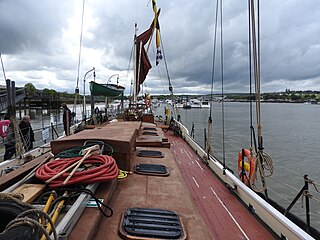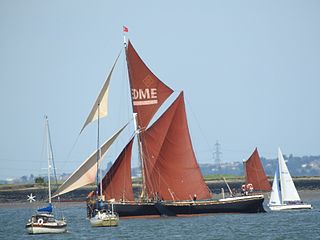
A Thames sailing barge is a type of commercial sailing boat once common on the River Thames in London. The flat-bottomed barges, with a shallow draught and leeboards, were perfectly adapted to the Thames Estuary, with its shallow waters and narrow tributary rivers. The larger barges were seaworthy vessels, and were the largest sailing vessel to be handled by just two men. The average size was about 120 tons and they carried 4,200 square feet (390 m2) of canvas sail in six working sails. The mainsail was loose-footed and set up with a sprit, and was brailed to the mast when not needed. It is sheeted to a horse, as is the foresail; they require no attention when tacking. The foresail is often held back by the mate to help the vessel come about more swiftly.

SB Cambria is a preserved spritsail Thames sailing barge now used for sail training. She was the last barge to trade entirely under sail, and took her last cargo in 1970. She is now restored and owned and operated by the Cambria Trust, a registered charity under English law.

Edith May is a wooden Thames sailing barge built in Harwich, Essex, in 1906. She was used to carry various cargoes until 1952, when a diesel engine was fitted, after which she was used in various Thames Sailing Barge matches, winning several. She was a museum ship for a time, and was restored in 2010 to offer charter trips on the River Medway. Her winter moorings are at Lower Halstow, where she opens during the weekend as a tearoom.

Lady of the Lea is a spritsail Thames sailing barge, the last such barge to be built in England. She was built in 1931 to carry explosives from Waltham Abbey Royal Gunpowder Mills on the River Lea to Woolwich Arsenal on the River Thames. The barge was later sold and rebuilt. She currently operates as a private yacht and competes in Thames sailing barge matches.

SB Centaur is a wooden Thames sailing barge, built in Harwich, Essex, England in 1895. She was used to carry various cargoes, mainly grain, for the next 60 years. During the First World War she carried food and coal to the French Channel ports. During the Second World War Centaur was damaged when sailing to assist with the Dunkirk Evacuation. She did war work for the duration of the conflict.

SB Pudge is a wooden Thames sailing barge, built in Rochester, Kent, England in 1922. Her hull was pitch pine on oak frame. She was originally spritsail rigged with bowsprit. An auxiliary oil engine made by The Bergius Co.Ltd of Glasgow was installed in 1932. She was used to carry various cargoes for the London & Rochester Trading Co until 1968, when she was bought out of trade by the Thames Sailing Barge Trust. Her last cargo was pineapple juice.

The SB Kathleen was a spritsail Thames barge built by Glover at Gravesend, Kent, in England in 1901, and registered in Rochester. Her official number was 113,708. She was built to carry grain- for capacity rather than speed. she was 82.8 feet (25.2 m) long and had a beam of 19.7 feet (6.0 m). Light, she drew 30 inches (76 cm) of water, and laden 6 feet (1.8 m).

SB Wyvenhoe is an 83-ton, steel Thames sailing barge. She was built by Forrest & Sons, Wivenhoe in 1898. She has the Official Number 110012.

Xylonite is one of seven Thames barges built between 1925 and 1930 for F W Horlock, Mistley. She was sold by the Horlocks in 1958 and cut down to a motor barge in 1958. Xylonite was re-rigged in the 1970s by Tim Eliff and replated on the 1980s. She has been used for sail training since 1983.
The Thames Sailing Barge Match is the second oldest sailing race in the world, beaten only by the America's Cup. It starts off Stanford-le-Hope and finishes off the Three Daws public house in Gravesend on the London River and is open to spritsail rigged Thames sailing barges, it uses the same course and rules as were used in the first match in 1863.

Kitty is a wooden Thames sailing barge in the bowsprit class of 65 tons. She was built in Harwich in 1895. She is No. 209 on the National Historic Ships Register.

SB Lady Daphne is a wooden Thames sailing barge, built in Rochester, England in 1923. She was used to carry various cargoes such as bricks and Portland stone on the River Thames and along the English Channel. She is infamous for sailing unaided from The Lizard to Tresco in the Scilly Isles, and safety beaching herself in two feet of water on shelving sand.

Reminder is one of seven Thames barges built between 1925 and 1930 for F W Horlock, Mistley.

Adieu is one of seven Thames barges built between 1925 and 1930 for F W Horlock, Mistley.

SB Niagara is a 79-ton Thames sailing barge, built by Forrestt at Wivenhoe, Essex, England in 1898 for the London and Rochester Trading Company. She carried cargo on the lower Thames and the English Channel. An auxiliary motor was fitted in 1924.

SB Marjorie is a 56-ton wooden Thames sailing barge, built by Orvis at Ipswich, Suffolk, England in 1898 for R. & W. Paul Ltd. She was used to carry various cargoes on the London River and along the Channel.

The Ena is a wooden Thames sailing barge constructed in Harwich in 1906 that is resting on the flats adjacent to Stargate Marina in Hoo, Kent. She is a notable Dunkirk little ship reputed to have rescued 100 men.

SB Decima is a steel Thames sailing barge constructed in Southampton in 1899 by J.G. Fay and Co, Southampton for E. J. Goldsmith of Grays, Essex. She is back under sail and resident on the River Darent in Dartford, Kent. She is a notable "Historic Ship".

Mirosa is a Thames barge which was built in 1892. From 1892 until 1947, she sailed under the name Ready when the name was sold to Trinity House for a lightship support vessel. Under her new name, she traded until 1955. Mirosa has never had an engine.

Edme is a Thames barge which was built in 1898 for the Horlocks of Mistley. She was registered in Harwich. She is one of two barge sailing today that have no auxiliary engine.



















